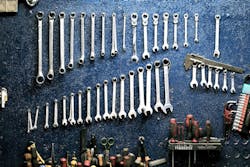In the town of Blue Ash, Ohio, shop owner Steve Wurtz has learned not “to put all [his] eggs in one basket.” Rather than rely heavily on one source of revenue, he believes it’s better to pay attention to potential gaps in the market and then capitalize on those opportunities. Over a period of eight years, he was able to expand his business, Blue Ash Auto Body, into three buildings, become a Tesla-certified repair shop and get equipped for aluminum repairs, all while eschewing DRPs.
Wurtz was nominated for the 2016 FenderBender Awards and he says his business strategy revolves around making cautious, strategic decisions.
His success, he says, comes from never wanting to incur too much debt and looking for ways to reach more customers, like through his shop’s additional towing service and work with local dealerships.
Reinvesting Over Time
Because Wurtz decided not to work with DRPs, he has had to keep up with industry changes, such as aluminum repairs and electric vehicles, to carve a niche in Ohio.
“We used to work with State Farm but we were doing repairs on high-end vehicles,” he says. “Our numbers were never going to look like other shops because the parts were double or triple the cost of regular model repairs.”
And he knew the key to carving a niche was to reinvest over a long period of time in these changes.
He has worked with Jaguar dealerships since 1994 and noticed that all the models had become a combination of aluminum and steel, so he figured it was advantageous to invest in aluminum repair certifications.
OEMs with vehicle makes that were partly aluminum provided a higher labor rate for his business, too, he says.
He sent technicians to San Jose, Calif., for six weeks of Tesla training. Now, he has two Tesla-certified technicians and two aluminum-certified technicians.
By investing at least 10 percent of his annual revenue into the business and not being afraid to make relationships with local dealerships, 60 percent of the shop’s business now comes from dealership referrals and the shop’s annual revenue is up to $3 million.
In addition to these investments, his towing service alone can bring in an additional 10–30 cars per week.
Location, Location, Location
When Blue Ash Auto Body opened in 1976, the town of Blue Ash was a lower-income area in Hamilton County, Ohio. Now, Wurtz says the area has completely changed into an affluent town.
The first shop building was only 2,800 square feet, a size that was just right for the size of the town, he says. Wurtz knew that if he grew the business, he would need to grow the square footage, as well. Eight years after opening, he moved into a new 5,000-square-foot building.
Part of his decision was spurred by the city manager’s master plan to redevelop the downtown area. The shop found its location in the industrial area and thought the new building size would be just right. When Wurtz saw the need to expand later into aluminum repair, he had to wait until it was “economically affordable.” So he waited about seven years and in the meantime rented space in a warehouse for extra repairs. He then built a 4,000-square-foot building for a fifth of the cost it would have been seven years prior.
But when Wurtz became an aluminum- and Tesla-certified shop two-and-a-half years ago, he needed separate areas to perform that work due to the possibility of cross contamination. Because he was worried putting curtains up was an insufficient solution to cross-contamination, he decided to acquire a building across the street from his existing two locations. Now, Wurtz has made the facility into a seven-acre property that includes a towing service for six local police departments.
Operating the Business
Wurtz uses his previous knowledge as a body shop painter and manager and relies on his toolbox of software management to manage his business.
But, he also allows his general manager to take over the logistics of operating three separate facilities and a towing lot.
“I spend time looking at the demographics in the industry [for Tesla and aluminum vehicle customers],” he says.
The majority of his business stems from steel work now, but that’s only due to waiting longer for aluminum and electric parts.
For Wurtz, he sees the industry resisting making investments of $150,000–$180,000 on new material certifications because it is a lot of money to come up with in a short amount of time. Yet, he plans to keep attaining the certifications and changing alongside the industry.




